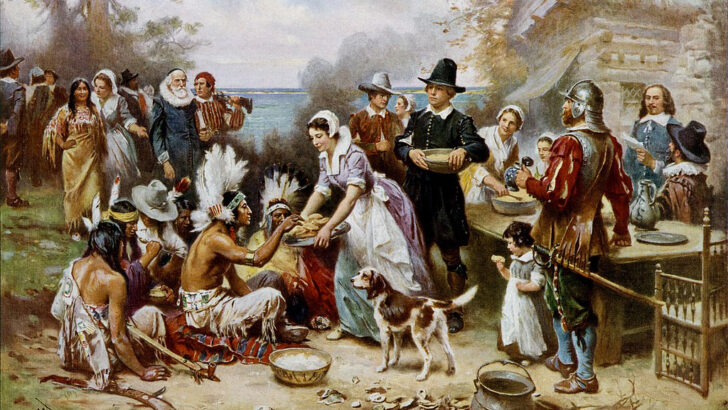Mayflower: A Story of Courage, Community, and War,
by Nathaniel Philbrick
(Penguin, £23.00 / €27.50); also The First Thanksgiving, a single chapter extract from the original book, is also available separately from Penguin booklet.
Today is Thanksgiving Day in the US. These books give a popular historical account of the Pilgrim Fathers, which broadens out the story to make the context clear. But in reality the modern popular ideas about the day are part of a foundation myth and often myths have little to do with the realities of history
For an ultra modern nation the United State of America is steeped in mythology. Thanksgiving is an important aspect of this.
It may derive from the ancient harvest home celebrations across Europe, but it has long meant that Christmas Day, one of the premier feasts of the Christianity, wherever established, is strangely neglected – indeed it is hardly a holiday at all in the US.
Resolution
Though it may look like an old rural feast, it was not in fact until October 6 1941 that Congress finally passed a joint resolution declaring the last Thursday in November to be the legal Thanksgiving Day, ending an era of confusion over the matter that had begun back in 1863.
It was supposed to celebrate the first season of the Pilgrims in the New World, and idealises the relations of the intruders with local Wampanoag people.
The national icon of this event is a much reproduced painting by Jean Louis Gerome Ferris, one of seventy eight paintings celebrating American history. This painting, made in 1915, portrays the settlers in a positive light, and legitimises the Pilgrims’ behaviour towards the Native Americans.
Contrary to the Thanksgiving myth, the Pilgrim-Wampanoag encounter was no first-contact meeting. Rather, it followed a string of bloody episodes since 1524 in which European explorers sold captured Wampanoags into slavery, or forced them to labour for the Pilgrims.
But by the date the picture was painted America had become , not the idealised white society of the painting but a multicultural society in which not only English and Dutch culture of the Puritans was mixed with the cultures of Italian and Polish Catholics, Swedish Lutherans and Russian Jews: very much the America we see today; though now with a further mixture of South Asian and Middle Eastern cultures.
But if we take an overview of the whole of the landmass of the United States we find something different. Leaving aside the displaced First Nations, the foundations of American society were not in north European Protestantism, but in south European Catholicism.
The oldest city, by date of foundation, in the continental US is St Augustine in Florida, established by the Spanish on September 8, 1565: remember Pilgrim Fathers only reached Cape Cod in November 1620. Catholic culture was for certain a strong element in the original creation of the US.
The Spanish settlers in Florida, which was ceded to the union in 1819, were then the first Latinos in the US territory. But later there followed the seizure of Texas in 1836.
Seized
Then in 1848, after the Mexican-American War, the US seized what are now the several states of California, Nevada, New Mexico and Arizona. The Gold Rush of 1849 in California created the basis of the state’s wealth, to which oil and minerals were later added. Thus more Latinos were Americanised.
Far from being the alien invaders of President-Elect Trump’s imagination, Latinos are among the earliest peoples settled in the USA.
But not all Latinos were “wet- backs” sneaking over the Rio Grande. In 1959, with the flight of Batista from Cuba, more émigrés, this time anti-Castroites fled into exile in Florida, creating a wealthy Latino social group that still remains important in the state’s politics.
As refugees from a harsh communist regime these people were welcome. But their presence and political position in Florida created another nuance in what «Latino» might mean in the present day US, for they have little in common with the other older Latino groups.
If this sounds like a complicated history, it is. Commentators like to simplify societies, but on the whole individuals are complex, and the societies they create are also complex. The supposed simple life of the Pilgrim Fathers, which Philbrick critically explores, is truly a thing of the past.


 Peter Costello
Peter Costello The First Thanksgiving , by Jean Louis Gerome Ferris, 1915
The First Thanksgiving , by Jean Louis Gerome Ferris, 1915 